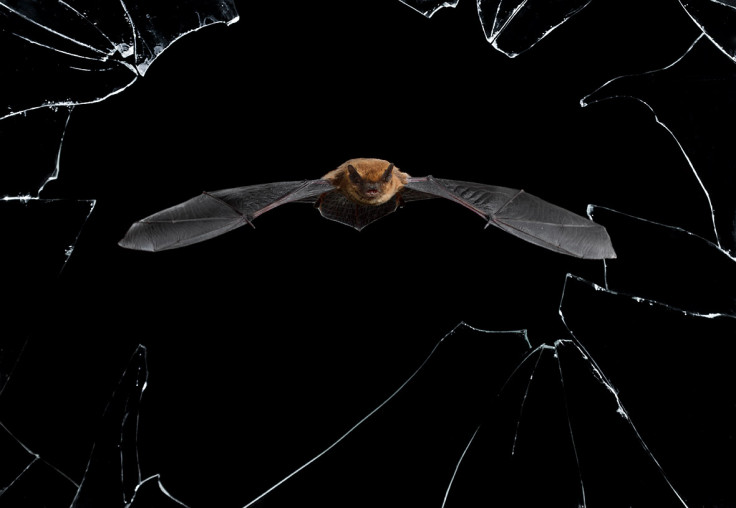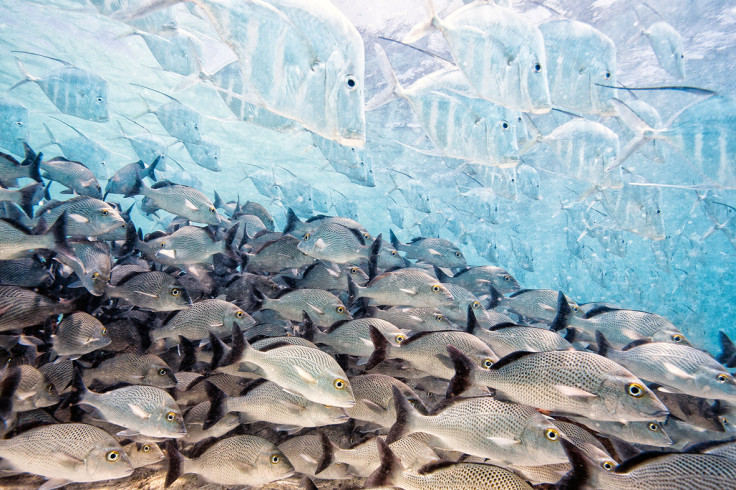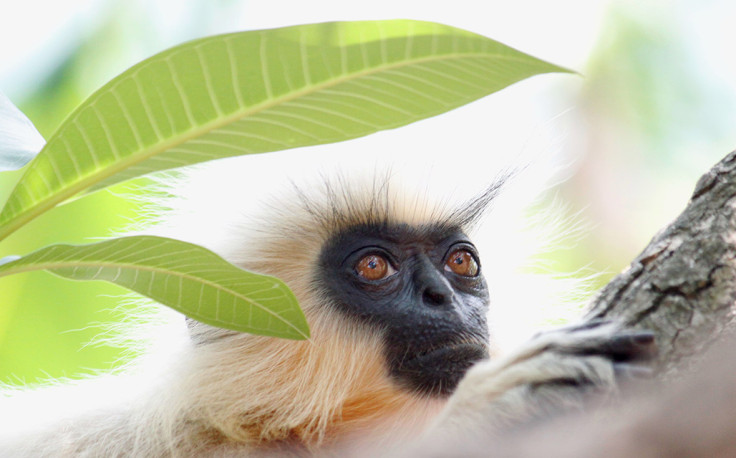First look at the 2016 Wildlife Photographer of the Year contest
Disappearing fish, a hungry hornbill and an inquisitive fox are among the highly-anticipated images.
The first images by finalists in the 2016 Wildlife Photographer of the Year competition have been revealed. Now in its 52nd year, the contest attracted nearly 52,000 entries from professionals and amateurs across 95 countries. The 100 finalists will go on show from 21 October at the Natural History Museum in London, which runs the annual competition. They will also embark on an international tour spanning six continents.
Collective courtship: Scott Portelli, Australia
Thousands of giant cuttlefish gather each winter in the shallow waters of South Australia's Upper Spencer Gulf for their once-in-a-lifetime spawning. Males compete for territories that have the best crevices for egg‑laying and then attract females with mesmerising displays of changing skin colour, texture and pattern. Rivalry among the world's largest cuttlefish – up to a metre (3.3 feet) long – is fierce, as males outnumber females by up to 11 to one. A successful, usually large, male grabs the smaller female with his tentacles, turns her to face him (as here) and uses a specialised tentacle to insert sperm sacs into an opening near her mouth. He then guards her until she lays the eggs. The preoccupied cuttlefish (the male on the right) completely ignored Portelli, allowing him to get close. A line of suitors was poised in the background, waiting for a chance to mate with the female (sometimes smaller males camouflage themselves as females to sneak past the male). Portelli's hours in the cold water were finally rewarded when the onlookers momentarily faced the same way, and he framed the ideal composition.

Nosy neighbour: Sam Hobson, UK
Hobson knew exactly who to expect when he set his camera on the wall one summer's evening in a suburban street in Bristol. He wanted to capture the inquisitive nature of the urban red fox in a way that would pique the curiosity of its human neighbours about the wildlife around them. This was the culmination of weeks of scouting for the ideal location – a quiet, well‑lit neighbourhood where the foxes were used to people (several residents fed them regularly) – and the right fox. For several hours every night, Sam sat in one fox family's territory, gradually gaining their trust until they ignored his presence. One of the cubs was always investigating new things – his weeping left eye the result of a scratch from a cat he got too close to. "I discovered a wall that he liked to sit on in the early evening," says Hobson. "He would poke his head over for a quick look before hopping up." Setting his focus very close to the lens, Hobson stood back and waited. He was rewarded when the youngster peeked over and, apart from a flick of his ear, stayed motionless for long enough to create this intimate portrait.

Crystal precision: Mario Cea, Spain
Every night, not long after sunset, about 30 common pipistrelle bats emerge from their roost in a derelict house in Salamanca, Spain, to go hunting. Each has an appetite for up to 3,000 insects a night, which it eats on the wing. Its flight is characteristically fast and jerky, as it tunes its orientation with echolocation to detect objects in the dark. The sounds it makes – too high‑pitched for most humans to hear – create echoes that allow it to make a sonic map of its surroundings. Cea positioned his camera precisely so that it was level with the bats' exit through a broken window and the exact distance away to capture a head-on shot. The hard part was configuring the flashes to reveal the bat and highlight the edges of the glass shards. His perseverance paid off when he caught the perfect pose as a bat leaves the roost on its night‑time foray.

Swarming under the stars: Imre Potyó, Hungary
Potyó was captivated by the chaotic swarming of mayflies on Hungary's River Rába and dreamed of photographing the spectacle beneath a starlit sky. For a few days each year (at the end of July or beginning of August), vast numbers of the adult insects emerge from the Danube tributary, where they developed as larvae. On this occasion, the insects emerged just after sunset. At first, they stayed close to the water, but once they had mated, the females gained altitude. They filled the air with millions of silken wings, smothering Potyó and his equipment in their race upstream to lay their eggs on the water's surface. Then they died, exhausted, after just a few hours. This "compensatory flight" – sometimes as far as several kilometres upstream – is crucial to make up for the subsequent downstream drift of the eggs and nymphs, and luckily for Imre, it was happening under a clear sky. To capture both the mayflies and the stars, he created an in-camera double exposure, adjusting the settings as the exposure happened. A flashlight added the finishing touch, tracing the movement of the females on their frantic mission.

Playing pangolin: Lance van de Vyver, New Zealand/South Africa
Van de Vyver had tracked the pride for several hours before they stopped to rest by a waterhole, but their attention was not on drinking. The lions (in South Africa's Tswalu Kalahari Private Game Reserve) had discovered a Temminck's ground pangolin. This nocturnal, ant-eating mammal is armour-plated with scales made of fused hair, and it curls up into an almost impregnable ball when threatened. Pangolins usually escape unscathed from big cats (though not from humans, whose exploitation of them for the traditional medicine trade is causing their severe decline). But these lions just wouldn't give up. "They rolled it around like a soccer ball," says Lance. "Every time they lost interest, the pangolin uncurled and tried to retreat, attracting their attention again." Spotting a young lion holding the pangolin ball on a termite mound close to the vehicle, Lance focused in on the lion's claws and the pangolin's scratched scales, choosing black and white to help simplify the composition. It was14 hours before the pride finally moved off to hunt. The pangolin did not appear to be injured, but it died shortly after, probably not just from the stress of capture but also from being out in the heat all day.

Blast furnace: Alexandre Hec, France
When the lava flow from Kilauea on Hawaii's Big Island periodically enters the ocean, the sight is spectacular, but on this occasion Hec was in for a special treat. Kilauea (meaning 'spewing' or 'much spreading') is one of the world's most active volcanoes, in constant eruption since 1983. As red-hot lava at more than 1,000˚C (1,832˚F) flows into the sea, vast plumes of steam hiss up, condensing to produce salty, acidic mist or rain. Hec witnessed the action and returned in an inflatable the following evening to find that a new crater had formed close to the shore. Capturing the furious action in a rough sea was no easy task. From 100 metres (328 feet) away, he was blasted with heat and noise – "like a jet taking off". In a moment of visibility, his perseverance paid off, with a dramatic image of glowing lava being tossed some 30 metres (98 feet) into the air against the night sky.

Thistle-plucker: Isaac Aylward, UK
Try keeping a flying linnet in sight while scrambling down rocky embankments holding a telephoto lens. Aylward did, for 20 minutes. He was determined to keep pace with the linnet that he spotted while hiking in Bulgaria's Rila Mountains, finally catching up with the tiny bird when it settled to feed on a thistle flowerhead. From the florets that were ripening, it pulled out the little seed parachutes one by one, deftly nipped off the seeds and discarded the feathery down. Aylward composed this alpine-meadow tableau with the sea of soft purple knapweed behind, accentuating the clashing red of the linnet's plumage.

The disappearing fish: Iago Leonardo, Spain
In the open ocean, there's nowhere to hide, but the lookdown fish – a name it probably gets from the steep profile of its head, with mouth set low and large eyes high – is a master of camouflage. Recent research suggests that it uses special platelets in its skin cells to reflect polarised light (light moving in a single plane), making itself almost invisible to predators and potential prey. The platelets scatter polarised light depending on the angle of the sun and the fish, doing a better job than simply reflecting it like a mirror. This clever camouflage works particularly well when viewed from positions of likely attack or pursuit. What is not yet clear is whether the fish can increase its camouflage by moving the platelets or its body for maximum effect in the ocean's fluctuating light. The lookdowns' disappearing act impressed Leonardo, who was free-diving with special permission around Contoy Island, near Cancun, Mexico. Using only natural light, he framed them against a shoal of grey grunt to highlight the contrast between them.

Golden relic: Dhyey Shah, India
With fewer than 2,500 mature adults left in the wild, in fragmented pockets of forest in north-eastern India (Assam) and Bhutan, Gee's golden langurs are endangered. Living high in the trees, they are also difficult to observe. But, on the tiny man-made island of Umananda, in Assam's Brahmaputra River, you are guaranteed to see one. Site of a temple dedicated to the Hindu god Shiva, the island is equally famous for its introduced golden langurs. Within moments of stepping off the boat, Shah spotted the golden coat of a langur high up in a tree. The monkey briefly made eye contact and then slipped away. Today, there are just six left on the island, and, with much of the vegetation having been cleared, the leaf-eating monkeys are forced to depend mainly on junk food from visitors.

Splitting the catch: Audun Rikardsen, Norway
Sometimes fishing boats look for killer whales and humpbacks, hoping to locate the shoals of herring that migrate to these Arctic Norwegian waters. But in recent winters, the whales have also started to follow the boats. Here a large male killer whale feeds on herring that have been squeezed out of the boat's closing fishing net. He has learned the sound that this type of boat makes when it retrieves its gear and homed in on it. The relationship would seem to be a win-win one, but not always. Whales sometimes try to steal the fish, causing damage to the gear, and they can also become entangled in the nets, sometimes fatally, especially in the case of humpbacks. The search for solutions is under-way, including better systems for releasing any whales that get trapped. Having grown up in a small coastal fishing community in northern Norway, Rikardsen has always been fascinated by the relationship between humans and wildlife. And for several years, he has been trying to document the interactions between whales and fishermen. A specially designed, homemade underwater camera housing allows him take split‑level pictures in low light. But he needs to get close to a whale, though not close enough to disturb it or be dragged under a boat's side propeller. So having the fishermen's permission to snorkel by their boats has been as important as being tolerated by the whales.

The 2016 Wildlife Photographer of the Year exhibition is at the Natural History Museum in London from 21 October 2016 to 10 September 2017. To book tickets, visit www.nhm.ac.uk/wpy
© Copyright IBTimes 2024. All rights reserved.






